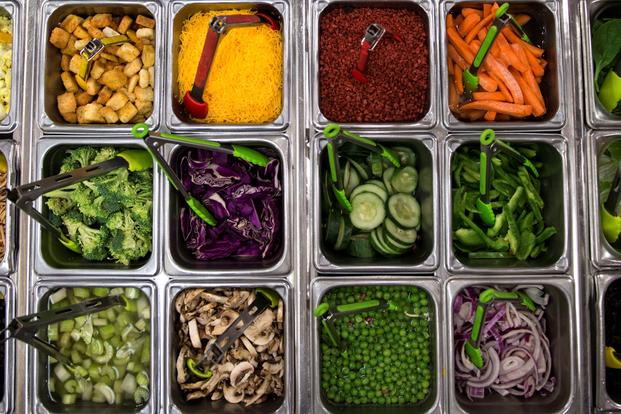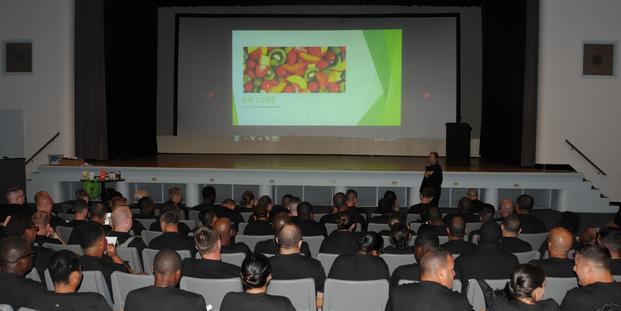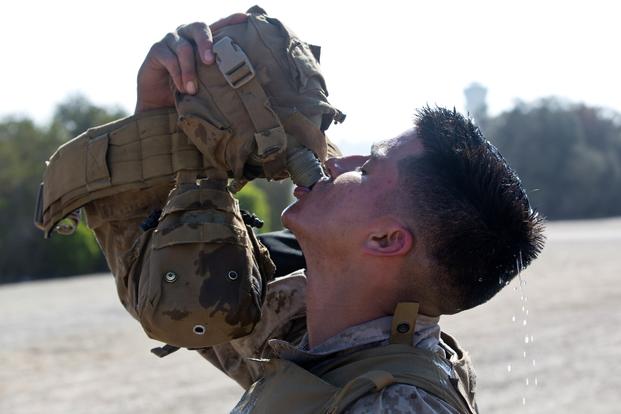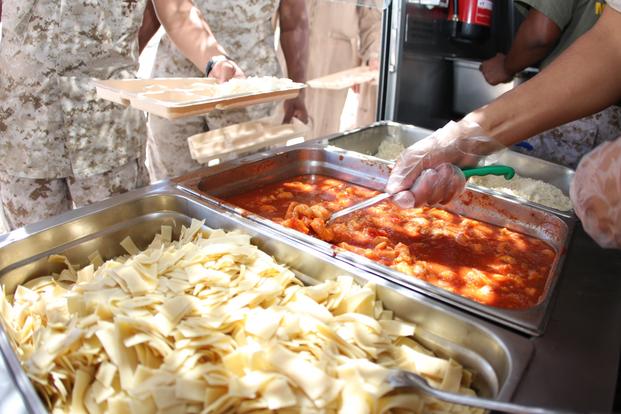Marines are about to see some major updates to their chow halls this fall -- the latest in a slew of changes the military services have made in recent years to get troops choosing healthier foods.
Like the rest of the country, the military is grappling with high rates of overweight and obese troops. More than 17 percent of soldiers were classified as obese in the Army's 2016 and 2017 Health of the Force reports. And even the Marines, who boast having the military's most stringent physical requirements, fight to keep thousands in the ranks from tipping the scales toward the overweight category every year.
That has leaders looking for new ways to fuel their warfighters. It's part of a push toward total fitness, which means nutrition doesn't just support troops' physical needs, but their psychological health as well.
Here's a look at how the changes could affect your future meals.
The Athlete's Table

Division I athletic programs offer up some top-notch cuisine, and Marine Corps leaders are taking notice.
From lean proteins like mahi-mahi steaks and bison meatloaf at the University of Nebraska to made-to-order breakfasts and recovery-focused performance plates at the University of Oregon, the high-speed college menus are serving as models for what Marines can expect to see this fall.
Col. Stephen Armes, director of the Marine Corps' Force Fitness Division, refers to it as setting "the athlete's table."
"I've got two sons that are both college athletes and their dining facilities are phenomenal," he said. "Everything on the chow line is good, and it's also good for you."
Nikki Jupe, the University of Oregon's senior sports dietitian, told Military.com that athletic performance is indirectly linked to nutrition. The right fuel can not only help someone take their physical talents to the next level with limited recovery time, but also lower their risk of injury and help them excel mentally.
All of that can benefit the military, she added.
"Incorporating the basic nutrition principles will build a foundation for mission readiness, cognitive performance as well as endurance performance," Jupe said. "Using different nutritional strategies [can also help] prepare for deployment."
Fueled to Fight
The physical and mental demands troops face on the job can be taxing, so leaders want to build up service members' strength, endurance and mental agility.
The Army's Performance Triad program is meant to enhance warfighters' physical and mental performance -- and nutrition-rich foods are one of the keys, leaders say. The Navy's Sailor 2025 program includes a pillar on fitness and nutrition mindfulness, and the Air Force recently revamped the way it fuels its special operators.
Sharlene Holladay, a certified specialist in sports dietetics who serves as the Marine Corps' warfighter and performance dietitian, is leading the charge to overhaul that service's dining options. Marines want food that helps enhance their performance in the field, she said.
So what can they expect to see?
"Cleaner proteins and better convenience-line grab-go options," she said. "Additionally, cold-bar options will offer traditional vegetables, chopped eggs, yogurt, cheese, salsa, legumes and trail mixes at all meals."
Marines in Okinawa, Japan, have been testing some of the new options for more than a year. They love the "cleaner fuel" additions, vegetarian options and the performance-enhancing foods, Holladay said.
Once the changes hit Marine Corps bases in the U.S. in October, Holladay and her team will continue collecting feedback and modifying menus to meet the wants and needs of the force.
The Navy stopped frying foods and selling soda aboard ships in 2014. And since the Army reported the highest rates of obese and overweight troops across the Defense Department, it has taken steps to improve nutrition in its 198 dining facilities.
"But we still have room for improvement," said Laura Mitvalsky, the director of health promotion and wellness at the Army Public Health Center.
A program called Go For Green "employs several nudging strategies to encourage soldiers to select healthy food and beverages," Mitvalsky said.
That includes labeling, food placement strategies, menu coding, featured plates, and educational marketing materials.
Fresh First

In the University of Oregon's athlete's cafeteria, Jupe said students always have access to a full salad bar, fresh fruit, two lean proteins, two starches, two vegetables and hydration options that include Gatorade products, juice, water and tea.
Those are the kinds of foods Armes said Marines will see as soon as they walk into the chow halls.
That's because they're working to front-load anything that supports a Marine's physical performance, Holladay added. The Marine Corps will still use its "Fueled to Fight" labels and the green, yellow and red color codes the Navy Department adopted a few years ago to help personnel make healthy choices.
"If the food is labeled green when you go through the chow line, go as much as you want," Armes said. "If it's yellow, go with caution. If it's red, go minimal."
The Army has its own set of labels in dining facilities, exchanges and commissaries meant to help soldiers make better food choices. They're also encouraged to ditch sugary beverages in exchange for fresh fruit in the Express shops and the salad bars in the dining facilities.
"Small changes are key to increasing fruit and vegetable intake and improve soldiers' nutrition status," Mitvalsky said.
Creature Comforts

Just because the healthy items will be featured prominently doesn't mean troops' burgers or pizza will go away entirely. But in Marine chow halls, leathernecks are going to have to walk a lot farther -- and past a lot of other ideal food options -- before reaching them, Armes said.
Any food can fit within a healthy meal plan, Holladay said, and they want to leave it up to individual service members to make informed choices. They just need to keep their mission and standards in mind, she said.
Army Exchanges have also worked to get healthier quick service options aboard installations, too, after soldiers surveyed complained that so many on-base fast food restaurants hurt their healthy-eating goals. Now they can hit up Subway, Qdoba or Muscle Maker Grill, Mitvalsky said.
The Exchange is also working with existing restaurants on base to highlight healthy menu options, she added.
Better Breakfasts

Troops rarely get to sleep in, and physical-training sessions that start before sunrise aren't uncommon.
But when Marine leaders took a look at how recruits and officer candidates at boot camp and OCS prepared for those sessions, they found many weren't getting the fuel they needed.
"They've been really skimpy on breakfast because they knew they were going to the PT event," Armes said. "Or they go right to the PT event with nothing in their stomachs."
Cold bars didn't always include fruits and yogurts Marines could grab on the go, he added. That's about to change with more quick-grab items in the works for those on the move, Holladay said.
Educating the Force

In order to combat the number of overweight or obese troops in the ranks, the military is going to need to help troops make better decisions.
That starts with developing proper habits, Jupe said.
"Understanding these habits starts with education," she said. "Having a combat-registered dietitian be a part of the process allows for insight and initial/extended education to aid in better habits and body composition change."
The Army is working on providing leaders with more actionable information and strategies on its Performance Triad program to get soldiers paying more attention to their sleep patterns, activity levels and nutrition. That includes a push to integrate the program into more training courses and a cooking guide for soldiers who want to add more whole foods into their diets.
Injury prevention

Military service isn't always easy on the body, but dietitians and leaders want troops thinking about how proper nutrition can help combat some of those stressors.
The Air Force is offering more anti-inflammatory foods like avocados and some berries to help special-operations airmen whose job puts a lot of pressure on their bones and joints. And the Marine Corps has been fielding new 500-calorie performance nutrition packs filled with high-carbohydrate foods at boot camp and OCS.
The packs help top off glycogen stores that dip overnight before a morning PT session, Armes said, which can help reduce the threat of heat-related injuries.
Holladay said Marine leaders already work to partner meal times and training schedules to minimize weather-related injuries. Making sure troops are educated about fluid-in and fluid-loss and providing simple energy sources -- like those performance nutrition packs, applesauce, fruit or cereal -- can also help.
"Education on the ways of fluid loss, PT and how to hydrate are important," she added. "Weighing in and out of activity, sweat testing, and assessing electrolyte levels are ways you can educate each individual to individually recover/prepare for PT. All of these tie back to how each person fuels their days for activity."
--Gina Harkins can be reached at gina.harkins@military.com. Follow her on Twitter at @ginaaharkins.











